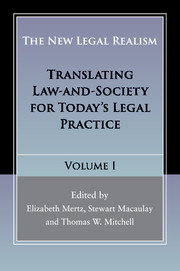Book contents
- Frontmatter
- Contents
- List of contributors
- Preface to The New Legal Realism, Volumes I and II
- 1 Introduction: New Legal Realism: Law and Social Science in the New Millennium
- Section I THE PLACE OF NEW LEGAL REALISM IN LEGAL THOUGHT AND TEACHING
- Section II PHILOSOPHY AND METHODS FOR A NEW LEGAL REALISM
- Section III NEW LEGAL REALIST TRANSLATIONS
- 10 New Legal Realism and Inequality
- 11 The Financial Crisis and Moral Accountability: Translating Practices of Risk, Profit, and Uncertainty
- 12 The Moment of Possibles: Some New Legal Realism about a “Reality Thriller” Case
- 13 Translating Law across Cultures and Societies: A Conversation with David Bellos and Kim Lane Scheppele
- 14 Is There a Lingua Franca for the American Legal Academy?
- Index
- References
11 - The Financial Crisis and Moral Accountability: Translating Practices of Risk, Profit, and Uncertainty
from Section III - NEW LEGAL REALIST TRANSLATIONS
Published online by Cambridge University Press: 05 May 2016
- Frontmatter
- Contents
- List of contributors
- Preface to The New Legal Realism, Volumes I and II
- 1 Introduction: New Legal Realism: Law and Social Science in the New Millennium
- Section I THE PLACE OF NEW LEGAL REALISM IN LEGAL THOUGHT AND TEACHING
- Section II PHILOSOPHY AND METHODS FOR A NEW LEGAL REALISM
- Section III NEW LEGAL REALIST TRANSLATIONS
- 10 New Legal Realism and Inequality
- 11 The Financial Crisis and Moral Accountability: Translating Practices of Risk, Profit, and Uncertainty
- 12 The Moment of Possibles: Some New Legal Realism about a “Reality Thriller” Case
- 13 Translating Law across Cultures and Societies: A Conversation with David Bellos and Kim Lane Scheppele
- 14 Is There a Lingua Franca for the American Legal Academy?
- Index
- References
Summary
The global financial crisis first struck the U.S. subprime mortgage market in 2007 and rapidly spread across the world over the next two years, devastating both credit markets and real economies in its wake. In May 2009, the U.S. government authorized the creation of a Financial Crisis Inquiry Commission (FCIC) to “examine the causes of the current financial and economic crisis in the United States” (2011, xi). At the FCIC's first public hearing in January 2010, the Commission probed the chiefs of the largest U.S. banks on their sale of financially unsound products such as subprime mortgage-related derivatives. These derivatives were the spark that lit the keg of the crisis, and the FCIC wanted to hold the banks accountable for the creation and sale of these “financial weapons of mass destruction” (Buffet 2003).
This chapter takes a close look at some of the key exchanges between the FCIC and the bank chiefs at the first public hearing. Hearings like these are usually taken to be situations that build up to a judgment or verdict. Insofar as situations of judgment seek to establish a chain of cause and effect, testimonies that are contradictory or ambiguous tend to be considered problematic. For a complex event like the financial crisis, the task of determining causes and attributing responsibility was bound to be difficult. The chains of events that led to the crisis were tangled up with each other and could stretch back for decades. The growth of financialization in the United States, for instance, was not the result of a deliberate and coherent plan but an unintended consequence of policy decisions going back to the mid-1960s (Krippner 2011). Over the course of time, the list of actors that could have been responsible for the financial crisis would run the gamut from banks and ratings agencies to the U.S. government, and even the American homeowner.
Taken as a situation of judgment, the public hearing with the banks was inconclusive. The FCIC's final report could not attribute the cause of the financial crisis solely to the banks’ trade in risky financial derivatives. Despite the efforts of the FCIC to capture the complexity of the crisis, the lack of a clear chain of cause and effect in the report prompted even a few of the Commission's own members to criticize it as “too broad” (FCIC 2011, 414).
- Type
- Chapter
- Information
- The New Legal RealismTranslating Law-and-Society for Today's Legal Practice, pp. 223 - 243Publisher: Cambridge University PressPrint publication year: 2016



